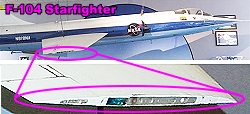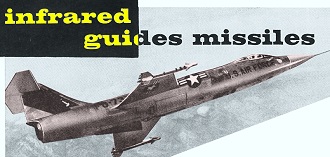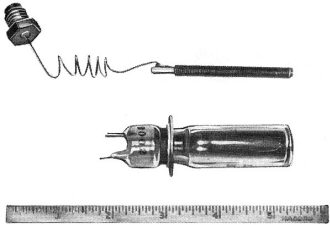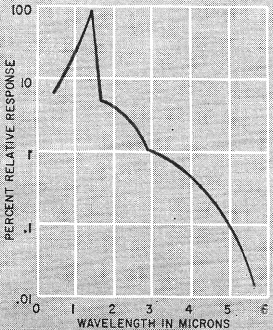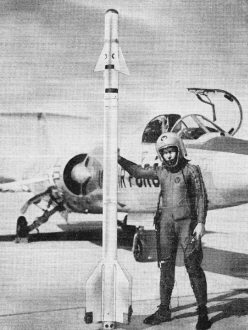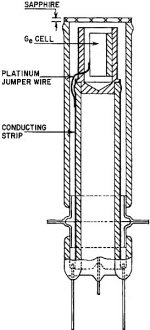Infrared Guides Missiles |
|
The Smithsonian website lists its top speed as 1,037 mph, while also claiming, "...the first U.S. jet fighter in service to fly Mach 2, twice the speed of sound ." Infrared Guides Missiles
By James R. Spencer* Recently, the US Air Force's F-104A Starfighter was armed with the Sidewinder, an infrared guided missile, to form a deadly aircraft-firepower combination. The 155-pound Sidewinder, a 9-foot missile that has been in use for more than 2 years, is guided to its target by infrared radiation emitted by the target. Thus the hot exhaust gases of an enemy plane become the target for this weapon. A Sidewinder, traveling at supersonic speeds, can actually zoom into the tailpipe of a jet aircraft to destroy it. Fig. 1 - Infrared radiation spectrum showing the three infrared regions.
Fig. 2 - Spectral response of a typical lead sulphide photocell. Fig. 3 - Gold-doped, single-crystal germanium infrared detector with the miniature cryostat that cools the detector to liquid nitrogen temperatures.
Fig. 5 - Spectral response of a gold-antimony doped germanium infrared detector. Fig. 6 - The Sidewinder infrared-guided air-to-air missile. The detection equipment is all in the nose, above the black band. Although the actual guidance equipment aboard the Sidewinder is classified, many general questions concerning infrared and the use of infrared in homing guidance can he answered. What is infrared? Infrared is a form of electromagnetic radiation, similar to visible light and radio waves. It is generated by thermal agitation and radiated by everything at a temperature above absolute zero (-273°C). High temperatures create more thermal agitation than low temperatures, so the infrared radiated by a hot object is more intense than from a cool one. The infrared portion of the electromagnetic spectrum ranges from 400,000,000 megacycles (the high limit where infrared borders on visible light) to approximately 1,000,000 mc (the low limit where infrared approaches the higher microwave frequencies). It is easier to measure infrared in terms of wavelength than frequency, so a standard unit of wavelength for infrared has been adopted. This unit is the micron - 1 micron is 1/10,000 centimeter long. The infrared portion of the spectrum is divided into three portions (see Fig. 1) - the near infrared from 0.75 to 1.5 microns; the middle infrared from 1.5 to 10 microns, and the far infrared from 10 to 300 microns. The horizontal scale in Fig. 1 is logarithmic. Infrared radiation can travel astronomical distances. The warmth from sunlight is infrared radiation that has traveled 93,000,000 miles. Only during the last few miles, when the radiation penetrates the earth's atmosphere, does it suffer any serious attenuation. Infrared is affected less by haze and light fog than visible light, but heavy clouds or rain can have a significant adverse effect. At high altitudes where air-to-air combat is likely, above 30,000 feet, infrared radiation suffers little attenuation from the light, thin atmosphere. Detecting infrared radiation In the laboratory, thermal detectors can be used to pickup infrared radiation. They sense the heating effect caused by absorbing the radiation. However, this method can not be used for missile guidance. Instead a photodetector forms the heart of the guidance system. In a photodetector, the absorbed photon energy either creates a voltage (photovoltaic cell) or causes a change in the conductivity of the detector (photoconductor). The photoconductive process is usually used because of the detector's small size, ruggedness and excellent infrared response characteristics. Lead sulphide photoconductors are one of the most extensively used types. In general, photodetectors have response characteristics that limit their usefulness to the near infrared region and a small part of the middle infrared region. Fig. 2 shows the response curve of a typical lead sulphide cell as a function of wavelength. Note that the response peaks at about 1 micron and begins to cut off quite sharply at approximately 2.5 microns. A recent development in photoconductors has extended their long-wave-length response. The new photodetectors are the indium antimonide and n- and p-type gold-doped germanium detectors. Fig. 3 shows one of them and the miniature cryostat (low-temperature thermostat) used to hold it at the normal operating temperature. Fig. 4 is a cross-section drawing of the detector's construction. The sensitive detecting elements are single crystals of indium antimonide or gold-doped germanium. Fig. 5 is the spectral response of an n-type gold-antimony-doped germanium detector. Compare this curve to the one for the typical lead sulphide cell (Fig. 2). An optical system in the nose of the missile gathers infrared radiation emitted by the distant target and focuses this radiation upon the detector. Electrical signals from the optical system are combined with the amplified detector signal to give target direction information. These data are compared with the missile heading and the result is an error signal which is fed to a servo control system. The end result is that the heading of the missile is constantly corrected to keep it on a collision course with the target. The equipment necessary for infrared guidance is relatively simple and very compact. It is all contained within the missile - above the black band in Fig. 6. With most guidance systems, the weakness is that the missile gets less and less accurate as it travels away from the guidance control source. But, if the source of control information is moved closer to the target, accuracy improves. For the ultimate in accuracy, the source of guidance control information should be at the target - and that's where the guiding infrared radiation originates. Whether an infrared-guided missile can be fooled or not is classified data. But remember, both jet and rocket engines produce large quantities of heat. Removing the source of this infrared radiation from either a jet or rocket powered target also removes the target's source of propulsion. * Technical Editor, Philco TechRep Division Bulletin.
Posted January 24, 2023 |
|

